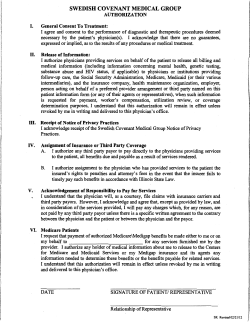
Comparison of primary care visits to physicians and non-physician
Comparison of primary care visits to physicians and non-physician providers in Community Health Centers and Hospital Outpatient Departments Health Resources and Services Administration (HRSA), NORC at the University of Chicago, Chicago University of Chicago Chicago, National Center for Health Statistics (NCHS) AcademyHealth 2014 Annual Research Meeting g June 10, 2014 Goal of broader study y • To better understand the healthcare services being provided in federally funded health centers • How care at health centers compares to other primary care settings • How health centers are using their workforce to provide services p 2 Introduction • This Thi study t d compares healthcare h lth services i ordered d d or provided by primary care physicians and nonphysician h i i providers id iin: • Federally-funded community health centers (CHCs) • Hospital outpatient departments (OPDs) • Non-physician providers include nurse practitioners, physician assistants, and certified nurse midwives 3 METHODS Description p of Data Source • NAMCS & NHAMCS collect data on ambulatory care visits Data Source Setting Provider type visit data collected National Ambulatory Medical Care S Survey (NAMCS) CHCs Physician and non-physician providers id POs Physicians (non-physician providers not sampled) OPDs Physician and non-physician providers National Hospital Ambulatory Medical Care Survey (NHAMCS) • Combined 2008-2010 data 5 Exclusion criteria • Focus on primary care visits • OPD sample restricted to primary care visits using approach described by Forrest & Whelan1 • Comparison p of p physician-only y y visits and nonphysician provider-only visits (NPs, PAs, CNMs combined)) • Excluded small number of visits involving both physicians and non non-physician physician providers and visits involving only other types of providers 1. Forrest, 1 Forrest C C.B. B and Whelan Whelan, E E.M. M 2000 2000. "Primary Primary Care Safety-Net Safety Net Delivery Sites in the United States." Journal of the American Medical Association, 284(16):2077-2083. 6 Description p of Data • Visit Vi it d data t iinclude: l d • patient demographic characteristics • visit characteristics – – – – – Reason for the visit Diagnoses Services ordered or provided Medications & immunizations ordered or continued Recommended follow up from the visit • Type of provider seen at the visit 7 Studyy Design g • Assessed A d relationship l ti hi b between t provider-type id t (predictor variable) and key outcome variables • Bivariate analysis • Chi Chi-squared squared tests of association • Multivariate analysis • Negative binomial model and logistic regression • Controlled for patient and visit characteristics 8 Outcomes Outcome Variable (service(s) ordered or provided at the visit) Total number of services up to 54 distinct services (includes up to 8 medications) Any mental health service mental health counseling, stress management, psychotherapy and depression screening psychotherapy, Any health education service education for asthma, diet/nutrition, exercise, growth/development, injury prevention, stress management, tobacco use/exposure, weight reduction, and other health education services provided y women’s health Any screening or preventive health service Any preventive service mammography, g p y, p pelvic exam,, p pap p smear,, bone density, y, and HPV DNA test cholesterol, glucose, Hba1c, PSA, bone density, mammography, h pelvic l i exam, d depression i screening, i chlamydia test, HPV DNA test, pap smear, and sigmoidoscopy or colonoscopy 9 Results Bivariate Results - CHCs • At CHCs, CHCs approx. approx 56% of visits were to physicians and 40% were to non-physician providers • At OPDs, OPDs 73% of visits were to physicians and 16% were to non-physician providers • Non Non-physician physician providers saw more patients living in less dense areas than physicians in both CHCs and OPDs • At CHCs,, a larger g p proportion p of non-physician p y p provider visits had the reason for the visit cited as preventive care (35% compared to 28%), while a larger proportion of physician visits were for a chronic issue or surgery (33% compared to 26%) 11 Multivariate Results - CHCs Visit Characteristics Total Number of Services, Average Adjusted Incidence Rate Ratio Visit Involved Any Mental Health Service Adjusted Odds Ratio Visit with Female Patients Involved Any Women's Preventive Health Service Adjusted Odds Ratio Visit Involved Any Health Education Service Adjusted Odds Ratio Visit Involved Any Preventive Health Service Adjusted Odds Ratio 95% confidence interval Physician Only Non-Physician Only 4.8 5.4 reference 1.15* 4% 10% reference 2.34* 14% 24% reference 1 33 1.33 39% 56% reference 1.88* 25% 35% reference 1.51* *Statistically significant (p-value ≤ 0.001) 12 Multivariate Results - OPDs Visit Characteristics Total Number of Services, Average Adjusted Incidence Rate Ratio Visit Involved Any Mental Health Service Adjusted Odds Ratio Visit with Female Patients Involved Any Women's Preventive Health Service Adjusted Odds Ratio Visit Involved Any Health Education Service Adjusted Odds Ratio Visit Involved Any Preventive Health Service Adjusted Odds Ratio (95% CI) 95% confidence interval Physician Only Non-Physician Only 5.6 5.4 reference 1.03 5% 6% reference 1.15 17% 16% reference 1.02 47% 50% reference 1.08 28% 25% reference 1.00 Note: None of the results are statistically significant. 13 Summary y • Findings suggest non non-physician physician providers are playing an important role in the delivery of primary care services by providing more care in rural areas of the country • Non-physician providers at CHCs are ordering/providing more services overall and more mental health,, preventive p care, and health education at each visit • At CHCs, a greater proportion of non-physician visits are with patients coming in for preventive care. • At OPDs, there were no differences found between services provided at physician and non-physician visits, indicating comparable care. 14 Implications p for Policy y • Some experts project a shortage of primary care physicians, suggest that non-physician providers could play an increased role as primary care providers, often in collaboration with physicians • Scope of practice policies for non-physician providers i impact t th the extent t t to t which hi h they th can serve as primary i care providers • We may be seeing more rural visits to non-physician non physician providers because of the lack of sufficient physicians in these areas 15 Authors • Sarah Downie, Downie NORC at the University of Chicago • Yue Gao, University of Chicago • Erin E i Tanenbaum, T b NORC att the th University U i it off Chicago Chi • Petry Ubri, NORC at the University of Chicago • Marie M i Dreyer, D NORC att the th University U i it off Chicago Chi • Elbert Huang, University of Chicago • Adil Moiduddin, M id ddi NORC at the h U University i i off Chi Chicago • Ravi Sharma, Bureau of Primary Health Care • Esther Hing, National Center for Health Statistics • Amanda Tzy-Chyi Yu, previously at NORC at the U i University it off Chicago Chi Insert Presentation Title and Any Confidentiality Information 16 Questions Q ti and d Discussion HCIA Evaluation - Disease Specific
© Copyright 2025











